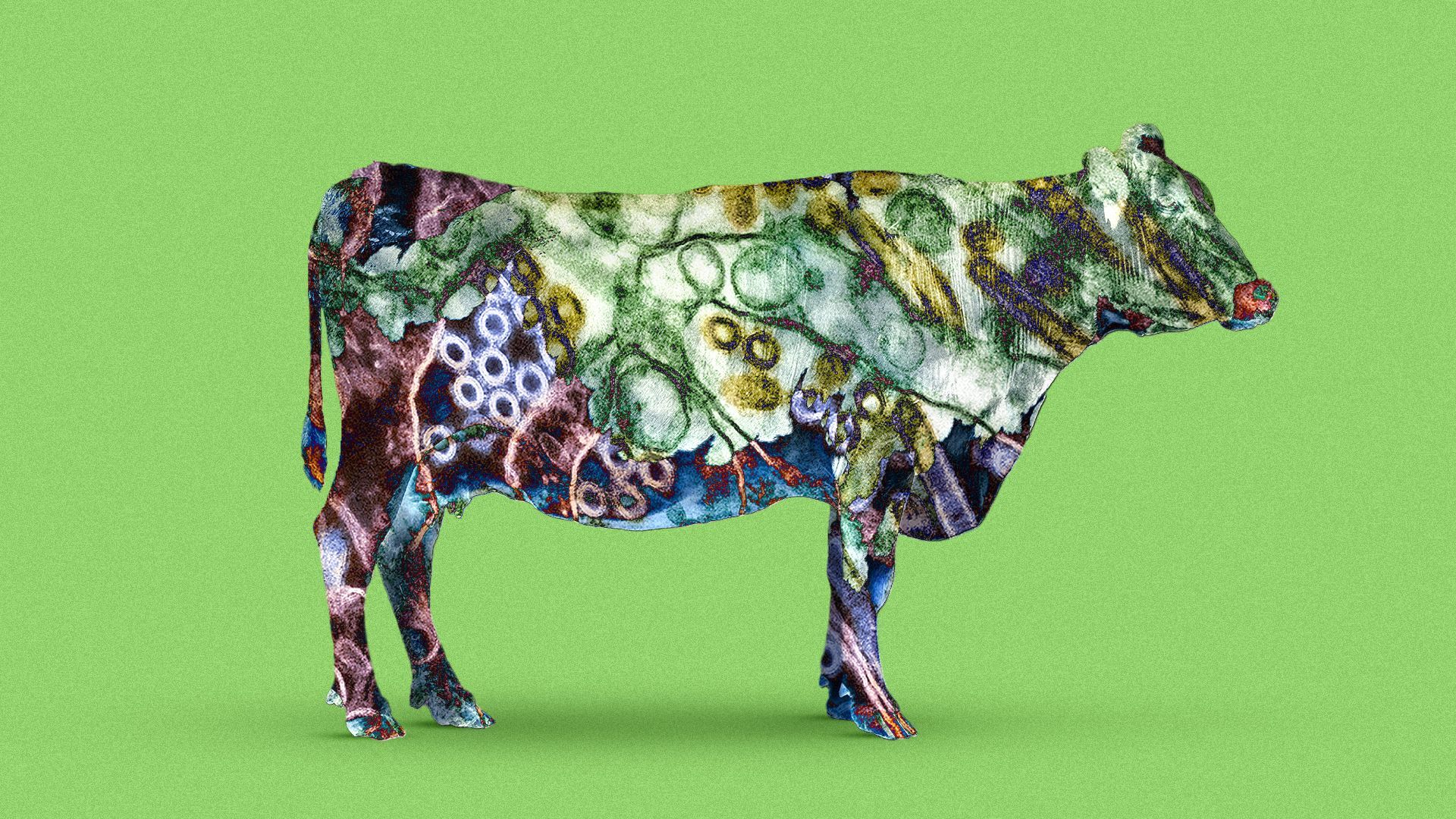
Illustration: Natalie Peeples/Axios
The bird flu outbreak in dairy cattle that's swept across nine U.S. states is posing perplexing questions about how the virus is spreading between animals and the risk posed to humans. Why it matters: Detecting viral spread early and limiting how long the flu circulates in a population of animals cuts the odds it will mutate and adapt to other species.
- The fact that the virus has infected a range of animals and is already in more than 30 herds — and the resulting potential for contact with humans and other animals — has public health experts' radar up.
"It's a really important moment," says Thomas Gillespie, a disease ecologist at Emory University.
- "At the moment, it is not a risk to the human public but we need to focus on the risk to the people working in the dairy industry who have direct interactions in a shared environment with cows," he said.
- "If we can't control that risk it could become a risk for the human population at large."
Catch up quick: The current version of H5N1 avian flu has circulated around the world since 2021, killing seals from Chile to Russia to Maine, a polar bear in the Arctic, red foxes in Europe and the U.S. and other species. It's also being detected in wild birds and farmed poultry.
- At the end of March, health officials announced they were investigating an outbreak of the virus in U.S. dairy cows, though it may have been circulating in cattle for months. It marked the first time avian flu was confirmed in cows, which become ill but recover with treatment.
- There's been one mild human infection detected so far, in a person exposed to dairy cattle, but some researchers suspect not all cases in workers are being spotted.
- An administration official told Axios it is "taking this outbreak seriously, and accelerating efforts across the U.S. government to coordinate our response," adding the CDC has said the risk to human health for the general public is low.

The virus' jump to cows poses new questions about it despite being studied for decades.
- "This is a different animal. We have to start all over again and understand what is going on," says Jürgen Richt, the director of Kansas State University's Center of Excellence for Emerging and Zoonotic Animal Diseases.
The big question is how it is spreading from one cow to another, Gillespie says.
- High amounts of the virus are being found in the udders of dairy cows and it's been detected in unpasteurized milk, suggesting it might be spreading through milking equipment.
- Preliminary studies found pasteurization inactivates the virus, so milk is considered safe to drink, a Food and Drug Administration spokesperson said in a press briefing yesterday. (Raw milk and cheeses may be a gamble.)
- It's also still possible it could be spreading in the air via droplets — or could adapt to.
Flu viruses typically mutate a bit as they circulate and replicate.
- But when a virus moves into a new species there are opportunities to re-assort larger segments of genetic material.
- A lot of times that's a dead end for the virus. But sometimes, that can "lead to something distinct enough that it can be more highly transmissible and cause greater morbidity and mortality," Gillespie says.
- This flu has more chances to jump – and therefore potentially adapt – to humans because of the proximity we have to stricken livestock.
The big picture: The strain spreading among cattle now is different from previous H5N1 strains, Richt says, which were often fatal when they first emerged in humans.
- "It shows higher virulence for a lot of mammalian species — except for humans," he says.
- "That's a very interesting development," he adds. "That is something we have to understand."
- "I don't see a smoking gun right now in the genome" for the virus becoming more virulent to humans, Richt says. "But I always say with flu it is only one or two mutations away."
What to watch: One potentially alarming scenario is if H5N1 virus in cows mixes with influenza viruses that are endemic to pigs. ("H" and"N" stand for two proteins found on the virus' surface that play a role in infection.)
- Swine are notorious mixing bowls for viruses that can eventually jump to humans, public health experts note.
- A USDA spokesperson told Axios there currently is no indication the virus is infecting pigs and that the department works with animal health officials and the swine industry to conduct surveillance.
- "We have to be very careful it doesn't move into pigs" and give rise to a "new genetic constellation" that may be more virulent, Richt says. In a preliminary study, he and his colleagues found this version of H5N1 can replicate in pigs but isn't transmissible.
- "Right now, it is a dead-end host. But all it takes is one mutation."